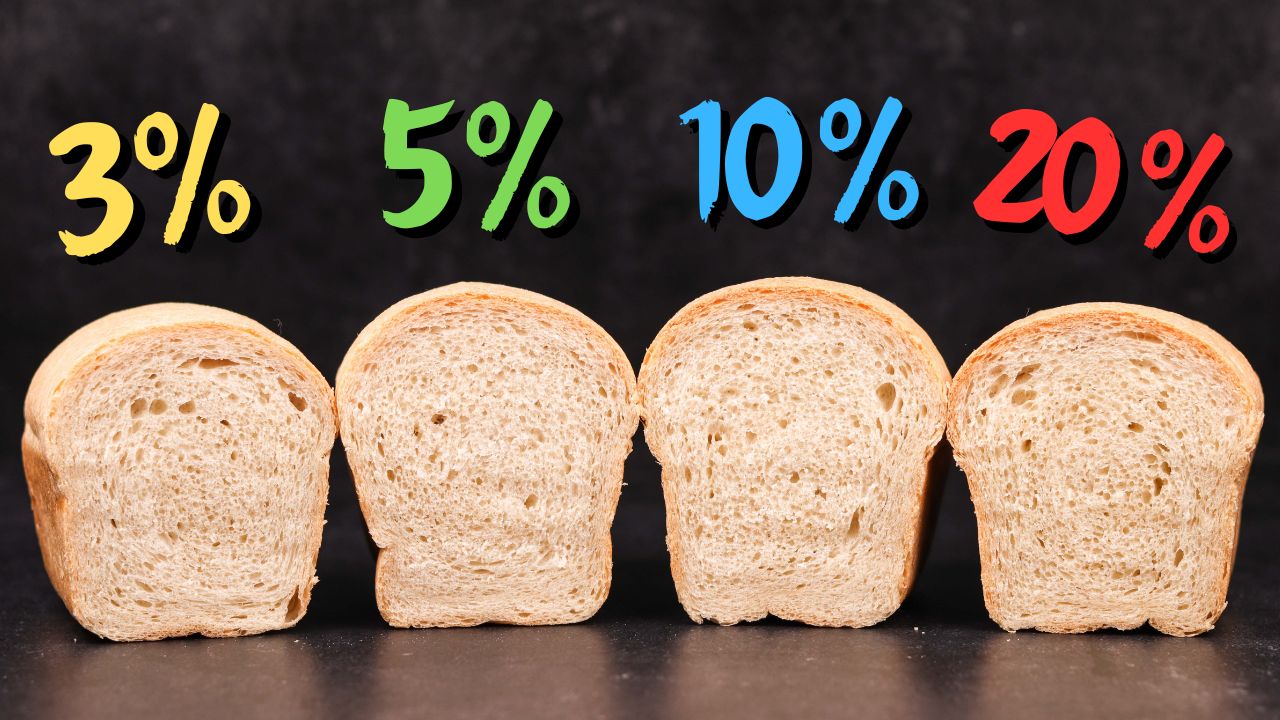Fat is a wonderful ingredient for bread making. It makes bread softer, moister, richer, longer lasting, and more delicious. There are several types of fats that can be added to bread dough. From various oils to butter, lard, goose fat or even bacon grease. Some of them carry distinct flavours and others only affect the texture and mouthfeel of bread. Which type of fat you use is totally up to you and your taste. There are no rules when it comes to using different fats. Cinnamon rolls could be made with lard, sandwich loaves could be made with bacon fat. It’s all down to your creativity and preference.
Fats coat the flour inhibiting formation of long gluten strands. That is why sometimes fat is called shortening. Gluten is made up of two proteins called glutelin and gliadin. It is when those proteins connect that gluten is formed. Shorter gluten strands equal weaker dough which results in a lighter and softer bread.
When deciding how much fat to add it is worth considering the other ingredients contained in the dough. High hydration dough would be difficult to handle if it also contained a relatively high amount of fat. Doughs that contain ingredients such as eggs and sugar also become trickier to work with when there is a lot of fat involved. The same goes for dough made with weaker flours such as low protein plain flour, spelt, einkorn or rye.
The type of bread also dictates how much fat it can take. If it is a sandwich loaf baked in a tin which supports its rise, then it could take more fat. If it is a free-standing loaf, then it may not rise as tall with a high fat content. Flatter breads can be fattier while taller breads should generally be leaner. Personally, I like to make my everyday breads with leaner dough and my super soft once in a while treat bakes with high fat dough.
The type of crumb that you want to achieve relies on the amount of fat. If the desired crumb structure is open and irregular, then a lower fat content is advised. If you want the crumb of your bread to be more compact and even, then more fat can be added.
When calculating fat content, we use baker’s percentage. Every ingredient added to bread dough is measured as a percentage in relation to the total amount of flour. The flour is always 100% in such a calculation. Example: a formula for a bread made with 500g flour, 350g water, 5g yeast, 10g salt, and 15g olive oil. We already know that the flour is 100%. To find the percentages of the other ingredients we simply have to divide the amount of the ingredient by the amount of flour.
Water 350:500 = 0.7 (70%); Yeast 5:500=0.01 (1%); Salt 10:500=0.02 (2%); Olive oil 15:500=0.03 (3%).
When writing a recipe from scratch we start with the amount of flour and then decide the percentages of the other ingredients. The following example is for a 500g flour recipe. 5% oil is 500×0.05=25g; 10% oil is 500×0.1=50g; 20% oil is 500×0.2=100g, and so on.
Since I stopped kneading dough, I have been adding fats right from the beginning of the mix instead of working them in later after gluten development. I have found that it works without any issues and that it is the most convenient way of adding fat. I have made brioche dough containing 40% fat several times without kneading and without compromises. That can give you a good idea of how much fat you can add to your bread dough.
Some fats affect bread dough differently than others. Butter is perhaps the most commonly used fat in bread making. What makes butter unique is that it usually consists of around 80% fat and that it is solid at room temperature. Most of the remaining 20% is water, so adding more butter to bread dough not only increases the fat content but also the hydration.
Oil on the other hand is 100% fat and it is liquid at room temperature. I like to calculate it as part of the total hydration when writing a new recipe. It is because oil will make the dough feel and behave as if it had a higher hydration. Of course, when writing a formula, it would be written down separately. Only when deciding how much I should add I would always look at the hydration percentage and then add the oil accordingly.
Butter tends to create a more uniform and smoother crumb while oils make it more open and irregular. Of course, it all depends on the amounts and the other ingredients contained in the dough as well as the hydration.
As for the experiment in the video, I chose a basic recipe to illustrate my point. As the amount of fat increased the aroma and taste became stronger and the crumb became progressively richer and softer. The crust also developed a deeper colour. Oil seemed to produce greater volume across the board.
When adjusting the formula for your next bake take all of the above into consideration. You can add as much or as little fat as you like. Experiment with it and find out what works best for you and your recipe. There is no ideal fat percentage. It’s all up to you.



